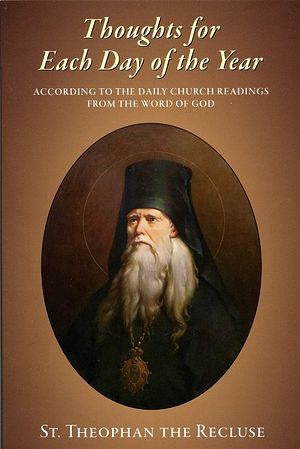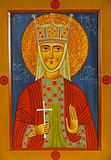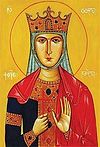

| Previous day | Next day |
| Old Style
September 13
|
Monday |
New Style
September 26
|
| 15th Week after Pentecost. Tone 5. | Fast-free period.
|
![]() Commemoration of the Founding of the Church of the Resurrection (the Holy Sepulchre) at Jerusalem (335).
Commemoration of the Founding of the Church of the Resurrection (the Holy Sepulchre) at Jerusalem (335). ![]() Forefeast of the Exaltation of the Cross.
Forefeast of the Exaltation of the Cross. ![]() Hieromartyr Cornelius the Centurion (1st c.).
Hieromartyr Cornelius the Centurion (1st c.).
Martyrs Serapion, Cronides, and Leontius, of Alexandria (ca. 237). Martyr Straton of Nicomedia (3rd c.). Martyr Seleucus of Galatia (320). Martyrs Elias, Zoticus, Lucian, Valerian, Macrobius, and Gordian, at Tomis in Moesia (320). Great-martyr Ketevan, queen of Kakheti, Georgia (1624). St. Cornelius of Padan-Olonets, disciple of St. Alexander of Svir, and with him Sts. Dionysius and Misael (16th c).
St. Litorius, bishop of Tours (370). St. Eulogius I, patriarch of Alexandria (608). St. John of Prislop (Romania) (15th-16th c.). St. Hierotheus of Kalamata, monk of Iveron, Mt. Athos (1745).
Repose of Monk Dorotheus, last hermit of the Roslavl Forests (1866).
Thoughts for Each Day of the Year
According to the Daily Church Readings from the Word of God
By St. Theophan the Recluse

Tuesday. [Gal. 2:21-3:7; Mark 6:1-7]
From whence hath this man these things? and what wisdom is this which is given unto him? Thus spoke the people of Nazareth about the Lord, having known His former life of low estate. The same happens with everyone who truly follows the Lord. He who strictly holds to the path of the Lord changes completely once he has labored to overcome all that is not right within himself. His whole constitution—his gaze, walk, speech, and behaviour all bear the mark of particular harmony and dignity, though he may have come from a lowly background, and has no education. It is then heard, “From whence hath this man these things?” If things that are bodily and visible are so transformed, what can be said of the inner things, of the soul, which are more directly and closely subject to the action of transforming grace, and to which the externals serve only as an expression and consequence? How bright, exact and determined are his thoughts about everything! How true is his judgment about what exists and occurs! His viewpoint on everything is higher than that of philosophers! And his intentions, actions and undertakings? All is pure, holy, reflecting heavenly brightness. In truth, this is a new person! He has not received an education, has not heard lectures in universities, and has no [illustrious] upbringing at all, and yet he is most well-mannered and wise. Attentiveness toward oneself, labour over oneself, prayer and drawing near to God refashioned everything through God’s grace; and nobody saw how it happened. That is why the question arises, “From whence hath this man these things?”
Monday. [Gal. 2:11-16; Mark 5:24-34]
The woman with the issue of blood had only to touch the Lord with faith, and power went out of the Lord into her: straightway the fountain of her blood was dried up. The issue of blood is an image of passionate thoughts and intentions, incessantly springing forth from the heart, if it has not yet been cleansed from all sympathy to sin—this is our sinful disease. It is sensed by those who have repented and zealously strive to keep themselves pure not only outwardly, but inwardly as well. Such people see that evil thoughts incessantly proceed from the heart, and they grieve over this and seek healing. But it is not possible to find such healing in oneself or others; it comes from the Lord, or more precisely, it comes when the soul touches the Lord and power goes out of the Lord into the soul. In other words, it comes when tangible contact with the Lord occurs, to which a particular warmth and inner burning testifies. When it happens, I say, immediately the soul feels that it “was healed of that plague.” This is a great good; but how can it be attained? The woman with the issue of blood pressed towards the Lord and received healing—we too must press towards the Lord, going without laziness by the narrow way of inner and outer spiritual endeavours. Everything is narrow and pressing for those who go by this way, and the Lord is not in sight. But then suddenly there is the Lord. And joy! The Kingdom of God does not come noticeably…
Articles
 Greatmartyr Ketevan the Queen of GeorgiaThe holy Queen Ketevan was the daughter of Ashotan Mukhran-Batoni, a prominent ruler from the Bagrationi royal family. |
 St John of PrislopSaint John was a monk of the Prislop Monastery in southwestern Romania at the turn of the sixteenth century. |






